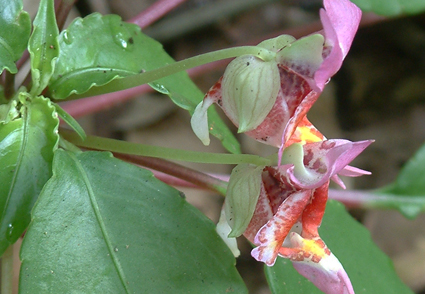Abstract
Impatiens mogangensis, a new species discovered in the limestone region of southeast Yunnan, China, is described and illustrated. Based on characteristics such as extremely contracted pedicels, connate lateral united petals, and four-locular ovary, this species is classified within Impatiens sect. Semeiocardium. Within the section, I. mogangensis resembles I. morsei morphologically in the white-tipped, yellow and brown-striated flowers, obconic capsule, and brick-shaped seeds. Additionally, I. mogangensis is similar to I. bonii in their reflexed lower lobes of lateral united petals, obconic capsules, and brick-shaped seeds, but can be distinguished from I. morsei and I. bonii by having 5–7 pairs of lateral leaf veins, serrate leaf margins, and falcate lower lobes of the lateral united petals. Besides, I. mogangensis is confined to the limestone region in Mogang village of south-eastern Yunnan and does not overlap with the distribution of I. morsei and I. bonii. In conclusion, the new species we proposed is a morphological transitional type between I. morsei and I. bonii respectively with their endemic geographical distributions.
References
- Chen, Y.L., Akiyama, S. & Ohba, H. (2007) Impatiens Linnaeus. In: Wu, Z.Y., Raven, P.H. & Hong, D.Y. (Eds.) Flora of China, 12. Science Press and Missouri Botanical Garden, Beijing and St. Louis, pp. 43–113.
- CVH (2024) Chinese Virtual Herbarium. Available from: https://www.cvh.ac.cn/ (accessed 6 June 2024)
- Ding, B.O., Wang, J.C., Deng, H.P & Wang, C.Y. (2017) Impatiens baishaensis (Balsaminaceae): a new species from Sichuan, China. Phytotaxa 319 (2): 191–196. https://doi.org/10.11646/phytotaxa.319.2.8
- GBIF (2024) The Global Biodiversity Information Facility. Available from: https://www.gbif.org (accessed 6 June 2024)
- Grey-Wilson, C. (2005) Impatiens morsei: Balsaminaceae. Curtis's Botanical Magazine 22 (3): 148–152. https://doi.org/10.1111/j.1355-4905.2005.00482.x
- Hooker, W.J. (1908) Icones plantarum or figures, with brief descriptive characters and remarks, of new or rare plants, selected from the author’s herbarium (Vol. 29, Issue 3). Longman, Rees, Orme, Brown, Green, & Longman, etc, pp. 2860 & 2874. Available from: https://www.biodiversitylibrary.org/page/16520670 (accessed 4 November 2024)
- Hu, T., Peng, S., Zhou, X.X., Zheng, Y.M., Cong, Y.Y & Hu, G.W. (2022) Two new species of Impatiens (Balsaminaceae) from Gaoligong Mountains, Yunnan, China. Phytotaxa 566 (3): 268–278. https://doi.org/10.11646/phytotaxa.566.3.2
- IUCN (2024) Guidelines for using the IUCN red list categories and criteria. Version 16. IUCN Red List Unit, Cambridge U.K. Available from: https://www.iucnredlist.org/resources/redlistguidelines (accessed 1 March 2024)
- Linnaeus, C. (1753) Species plantarum. Laurentius Salvius, Stockholm, 937 pp.
- Mabberley, D.J. (2008) Mabberley’s Plant Book: A portable dictionary of plants, their classification and uses. Cambridge University Press, UK, pp. 1–754.
- Peng, S., Cong, Y.Y., Tian, J., Zhang, C.F., Hu, G.W & Wang, Q.F. (2021) Impatiens bullatisepala (Balsaminaceae), a new species from Guizhou, China. Phytotaxa 500 (3): 217–224. https://doi.org/10.11646/phytotaxa.500.3.5
- POWO (2024) Plants of the World Online. Facilitated by the Royal Botanic Gardens, Kew. Available from: http://www.plantsoftheworldonline.org/ (accessed 6 June 2024)
- Ruchisansakun, S., van der Niet, T., Janssens, S.B., Triboun, P., Techaprasan, J., Jenjittikul, T & Suksathan, P. (2016) Phylogenetic analyses of molecular data and reconstruction of morphological character evolution in Asian Impatiens section Semeiocardium (Balsaminaceae). Systematic Botany 40 (4): 1063–1074. https://doi.org/10.1600/036364415x690102
- Ruchisansakun, S., Suksathan, P., van der Niet, T., Lwin, S. & Janssens, S.B. (2017) Impatiens tanintharyiensis (Balsaminaceae), a new species from southern Myanmar. Phytotaxa 296 (2): 171–179. https://doi.org/10.11646/phytotaxa.296.2.6
- Shui, Y.M. & Chen, W.H. (2006) Seed Plants of the Karst Region in China. Vol. 1, Southeast Yunnan. Science Press, Beijing, pp. 1–260.
- Shui, Y.M., Janssens, S., Huang, S.H., Chen, W.H & Yang, Z.G. (2011) Three new species of Impatiens L. from China and Vietnam: preparation of flowers and morphology of pollen and seeds. Systematic Botany 36 (2): 428–439. https://doi.org/10.1600/036364411x569615
- Suksathan, P. & Ruchisansakun, S. (2022) Impatiens of Thailand. Natural History Publication. Borneo, pp. 1–396.
- Thiers, B. (2024) Index Herbariorum: A global directory of public herbaria and associated staff. New York Botanical Garden’s Virtual Herbarium. Available from: http://sweetgum.nybg.org/ih/ (accessed 17 September 2024)
- Utami, N. (2009) The status of Semeiocardium Zoll.(Balsaminaceae). Reinwardtia 13 (1): 21–23.
- Xia, C.Y., Gadagkar, S.R., Li, J.I.N., Deng, H.P & Yu, S.X. (2019) Impatiens damingensis (Balsaminaceae), a new species from Guangxi, China. Phytotaxa 399 (3): 239–247. https://doi.org/10.11646/phytotaxa.399.3.6
- Yu, S.X., Hou, Y.T., Chen, Y.L & Qin, H.N. (2009) Impatiens lobulifera (Balsaminaceae), a new species from limestone areas in Guangxi, China. Botanical Studies 50 (3): 365–370.
- Yu, S.X., Xu, W.B., Chen, Y.L & Qin, H.N. (2010) Supplementary description of floral morphology of Impatiens hainanensis and I. morsei (Balsaminaceae). Guihaia 30 (1): 33–35.
- Yu, S.X. (2012) Zhongguo Fengxianhua [Balsaminaceae of China]. Peking University Press, Beijing, pp. 1–206.
- Yu, S.X., Lidén, M., Han, B.C & Zhang, X.X. (2013) Impatiens lixianensis, a new species of Balsaminaceae from Sichuan, China. Phytotaxa 115 (1): 25–30. https://doi.org/10.11646/phytotaxa.115.1.3
- Yu, S.X., Janssens, S.B., Zhu, X.Y., Lidén, M., Gao, T.G & Wang, W. (2016) Phylogeny of Impatiens (Balsaminaceae), integrating molecular and morphological evidence into a new classification. Cladistics 32 (2): 179–197.
- Yuan, Y.M., Song, Y., Geuten, K., Rahelivololona, E., Wohlhauser, S., Fischer, E., Smets, E & Küpfer, P. (2004) Phylogeny and biogeography of Balsaminaceae inferred from ITS sequences. Taxon 53 (2): 391–404.
- Zeng, L., Liu, Y.N., Gogoi, R., Zhang, L.J & Yu, S.X. (2015) Impatiens tianlinensis (Balsaminaceae), a new species from Guangxi, China. Phytotaxa 227 (3): 253–260. https://doi.org/10.11646/phytotaxa.227.3.4


